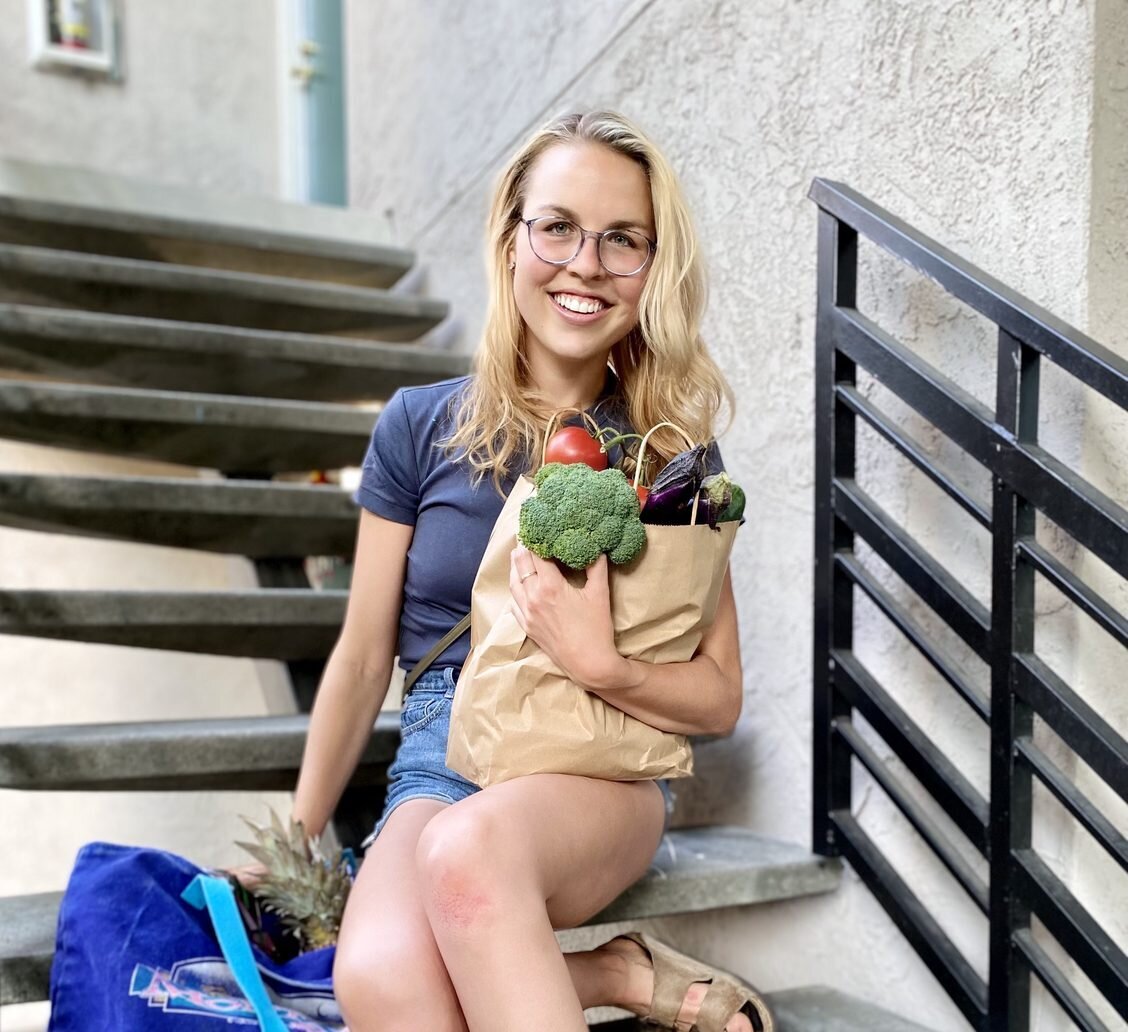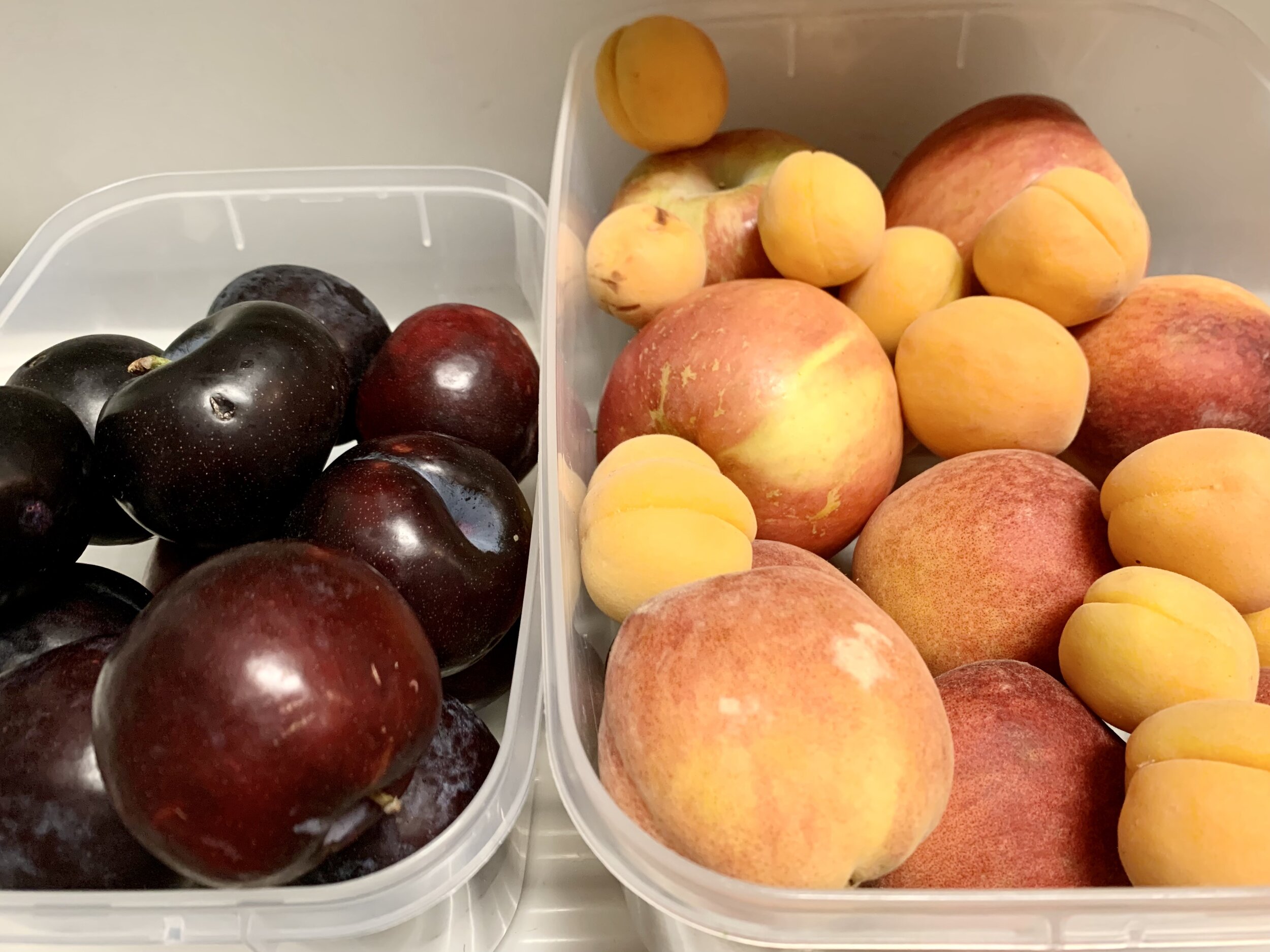How to keep produce fresh for weeks
The author shortly before sorting her produce into compatible storage bins.
There are few things that make me happier than shopping for my week’s haul of fresh fruits and vegetables. I’m actually serious. How else to explain why, on the eve of my produce runs, I park cross-legged in front of my open fridge and take inventory on the back of a junk-mail envelope. I’m not ashamed about how excited I get replenishing my vegetables, but it’s not something I share on first dates.
Shopping gives me a chance to meet people at the farmer’s market, take note of what’s in season, and look for cooking inspiration. Every week is a little different, since I like to try out new shopping venues. But for years, my post-shopping routine has been the same. Basically, I unpack my grocery totes straight into the fridge, to keep them fresh.
So why, after two or three days, do my carefully chosen fruits and veggies start to sag, wilt, and wrinkle? For a long time I assumed it was normal. Obviously, fresh can’t stay fresh, right? Well, yeah. But—after checking into cooking blogs and eavesdropping at the food co-op—-it’s clear my produce was aging really fast!
“I’m not ashamed about how excited I get replenishing my vegetables, but it’s not something I share on first dates.”
I decided to look into why I was wasting almost half of what I bought each week. It turns out I was storing them incorrectly. According to studies from Cornell and the University of Maine and Kansas City State Cooperative Extension, matching your melons, potatoes, and tomatoes to just the right level of humidity, air flow conditions, and temperature range is the golden ticket to giving your produce the longest shelf life possible.
In my case, thanks to some vague logic about lower temperatures slowing rot, I had erred on the side of refrigeration. Cool or cold temperatures can indeed slow the ripening process for some produce and preserve the cell structures of others—leafy greens, cucumbers, and celery, which require a high-moisture atmosphere to stay crisp, come to mind.
But a refrigerator’s high humidity can also cause the starches in certain produce, like potatoes, onions, and squash, to break down too quickly. This accelerated breakdown can turn these vegetables soft and sour. Janet White from the Michigan State University Extension explains that in some produce, like white potatoes, it can even lead to a build up of toxic chemicals that can’t be cooked off.
To refrigerate or not? IT Depends on THE family
The way to sort your produce into a fridge, pantry, or countertop bowl is by family. Produce families are organized by specific physical characteristics, like whether they have pits, hard rinds, leafy tops, or root bodies. Because the produce in each family shares a common physical make-up and structure, they react in much the same way when stored in the same environment.
Temperature is an important storage consideration, but so is the degree of air circulation. This is because certain fruits and vegetables release large quantities of ethylene gas, a naturally occurring ripening agent. Too much of it in an enclosed area accelerates the ripening of the item releasing the gas, as well as everything else in its vicinity.
The third key factor is humidity. If an item benefits from staying moist, seal it in a container or bag. If moisture could lead to mold or rot, keep it in an open or lightly sealed container.
In other words, it’s not that hard to store produce correctly—and it’s rewarding. By taking the time to get to know my go-to fruits and vegetables, I’ve been able to save money on my weekly grocery bills, lower my personal waste level, and cut back on the number of soups I make to absorb all that aging produce.
Every now and again, you’ll still find me whipping up a ‘last ditch’ banana bread or a ‘clean out the crisper’ curry, but at least these dishes are no longer standard weekly operating procedure.
Keep produce fresh by family
The members of each fruit and vegetable family are related, which means they have similar storage needs. Figure out which family your veggies come from, and you’ll know if they’ll be happiest hanging out in a fridge, on a counter, or in a dark, cool space.
Note: Regarding the length of storage time: this does not indicate when produce will go bad or need to be tossed. It just suggests the range of time your vegetables and fruits are likely to be at their best.
My potatoes live in an old crate in my pantry. This is the most light they’ve seen in awhile!
Tough peeled tubers and gourds. Yams, russet, Idaho, red, sweet, fingerling, and Yukon gold potatoes. Pumpkins, winter, acorn, butternut, spaghetti, and buttercup squash.
Storage: Keep your spuds and squash in a cool, well-ventilated, dry, and dark space. These hearty spuds and gourds will do fine in a root cellar, breathable basket, or crate kept on the bottom shelf of your pantry.
Length of storage time: Most tubers last about three to four weeks. Sweet potatoes don’t last as long; best to eat them within one to two weeks. Hearty gourds can stick around for as long as three to five months.
Note: Potatoes and onions don’t get along well. Store your onions and garlic in an open basket or bowl a few shelves away from the potatoes.
Carrots do best if you trim off the greens and keep them refrigerated. Wash only when you’re ready to eat.
Root vegetables. Carrots, turnips, beets, radishes, parsnips, rutabagas, turnips, jicama, kohlrabi, and ginger.
Storage: Keep your root vegetables unwashed, sealed, and refrigerated. The goal here is to keep your root vegetables dry to prevent mold from growing, so trim their stems and leaves but don’t rinse them. Excess moisture will make them go limp more quickly.
Put the trimmed veggies into sealed containers, and tuck them into the fridge—no need to buy any specially engineered crisping containers. Just make sure the container is non-permeable, hard plastic or glass, with a lid that seals or locks into place.
Note: If you’re short on containers, trim the greens (use them as sides, salads, and in soups!) and put them in a plastic bag. Tie off the bag, or seal and zipper it shut.
Length of storage time: Root vegetables will retain their original texture and color for about three to four weeks. After that, they may start to bend and be less vibrant—though they’ll still do well in soups, stocks, and sauces. Or crisp them back up by soaking them in a bowl of water and sticking it in the fridge for about an hour.
I’ve always had issues with my leafy greens and cruciferous veggies going limp in the plastic bags from the grocery store. Sealed containers are a game-changer, though sealed plastic bags can work, too.
Leafy greens, cruciferous vegetables, and herbs. Lettuce, spinach, Swiss chard, arugula, watercress, collard greens, kale, broccoli, cauliflower, cabbage, brussel sprouts, broccolini, basil, cilantro, parsley, and mint.
Storage: Keep them cold, sealed, and unwashed. This particular veggie family is fairly low maintenance. Just get them into a sealed container, and tuck them into the fridge. Don’t wash or trim them. Any excess moisture will cause the leaves to lose their crispness.
Note: If you’re short on containers and would like to keep them in plastic bags, make sure not to wash them first.
Length of storage time: You can expect leafy greens and cruciferous vegetables to last one to two weeks.
Food waste tip: Those greens you trimmed off your root vegetables? They can be stored right along with the rest of your leafy greens and used for soups, stews, stir fries, and braises.
Seed fruits and stone fruits. Apples, pears, peaches, plums, nectarines, apricots, cherries, and pluots.
Storage: Keep them cold, in a crisper, and unwashed. The first step to storing the seed fruits and stone fruits is to make sure they’re ripe. If they aren’t ripe when you buy them, put them in a paper bag, roll down the top, and stash it somewhere they won’t get bumped.
Check your fruits daily until they’re soft without being squishy. As tempting as it sounds, don’t put your unripe fruits straight into the fridge with hopes of setting them on the counter to ripen later. Sadly, this leads to mealy, bland flesh.
Although these would look lovely in a bowl on the counter, the crisper does wonders for their flavor, texture, and juice content.
Apples are the exception. Self-ripening is usually only necessary if you’re getting them from an independent grower.
Once your fruits have the desired consistency and smell good, they’re ready to store. Keep them unwashed and unwrapped in a crisper drawer.
Length of storage time: In general, these fruits will last one to two weeks, but some varieties of apples will last longer.
Thank goodness for the paper towel! Stuff one or two in with your berries and they’ll sop up the extra moisture that can hasten mold and rot.
Berries. Strawberries, raspberries, blackberries, blueberries, blackberries, cranberries, elderberries, huckleberries.
Storage plan: Keep your berries cold, moderately well-ventilated, and unwashed. The berry family is the fussiest. As with stone and seed fruit, berries must be ripe before storing or they’ll quickly turn to mush. Before putting your berries away, pick out any that are already squishy or moldy.
Don’t wash them! Any trapped moisture will accelerate mold growth. Allowing air to circulate can stave off mold, so keep them in their original berry container or in a loosely covered colander. Tuck a dry paper towel into the bottom of the container to absorb excess moisture.
Length of storage time: Berries are best eaten within five days of being purchased or picked.
Citrus fruits, tropical fruit, and melons. Oranges, lemons, limes, tangerines, clementines, watermelon, jackfruit, pineapple, bananas, cantaloupe, and honeydew.
Storage: Keep fruit at room temperature, well-ventilated, and dry. These beautiful fruits pair nicely with gorgeous ceramic fruit bowls. Hold off on peeling and cutting them until just before you’re ready to eat them. Send any leftovers straight into a sealed container, and pop it into the fridge.
Length of storage time: Your uncut tropical fruit will last for one to two weeks—except for bananas. Plan to eat those within the week.
My tropical and citrus fruits bring so much light and life to my pocket-size kitchen. I only wish I had more counter space.
Josie Braaten is a Stone Pier Press News Fellow based in Sunnyvale, CA.















